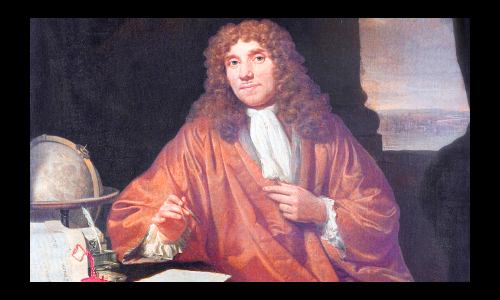
But with further research, it was realized that these creature,s called protozoa to modern scientist, are. He was born on october 24, 1632, in the small city of delft in the dutch republic.

His mother, who came from a wealthy family, would then marry a painter.
Biographie von anton van leeuwenhoek. Anton van leeuwenhoek is often credited as being the inventor of the microscope, but that is not actually the case. Antonie van leeuwenhoek was born in delft on 24 october 1632. Anton van leeuwenhoek was born in 1632 in the city of delft, which was located in the dutch republic.
His only formal education was some elementary school. 1958 antony van leeuwenhoek and his little animals, p. The microscopes of antoni van leeuwenhoek by j.
Leeuwenhoek�s primitive microscope, actually a lens mounted between two metal plates. He is best known for developing and improving the microscope , which then allowed him to make important contributions in the scientific field of microbiology. His schooling was informal, probably including some mathematics.
Antoni van leeuwenhoek, who lived in the netherlands between 1632 and 1723, was an amateur in science and lacked any type of formal university training. It would also be unfair to remember him for that and that alone, because his contributions to microbiology were far more extensive and important. Robert hooke who described the fruiting structures of molds in 1665 and antoni van leeuwenhoek who is.
Leeuwenhoek also studied head and body lice. In 1648, van leeuwenhoek was apprenticed to a textile merchant, which is where he probably first encountered magnifying glasses, which. He was a businessman who made his own revolutionary microscopes.
Antonie van leeuwenhoek is the official journal of the royal dutch society for microbiology, and we have joined forces to reinvigorate the journal as an outlet for high quality studies in the tradition of the dutch school of microbiology. Van leeuwenhoek was a dutch scientist who changed the world with his discovery of single celled organisms in 1676. Know how bacterial cells were discovered by dutch scientist leeuwenhoek, along with 8 unknown facts about the microscopic living.
His researches on lower animals refuted the doctrine of spontaneous generation , and his observations helped lay the foundations for the sciences of bacteriology and protozoology. Antonie van leeuwenhoek was a renowned scientist of the seventeenth century whose pioneering research works, laid the founding stone for emergence of microbiology as a stream. Antonie van leeuwenhoek was born on october 24, 1632, in the small city of delft in the dutch republic.
Antonie van leeuwenhoek was a dutch scientist, naturalist, businessman and microscopist. What is anton van leeuwenhoek best known for? Antonie van leeuwenhoek is the 6th most popular biologist (up from 7th in 2019), the 11th most popular biography from netherlands (up from 13th in 2019) and the most popular dutch biologist.
Van leeuwenhoek is best known for his pioneering work in the field of microscopy and for his contributions toward the establishment of microbiology as a scientific discipline. Letter from leeuwenhoek to constantijn huygens and hooke, 20 may 1679, translated in dobell c. Two men are credited today with the discovery of microorganisms using primitive microscopes:
Antonie’s early life was rather rocky: Raised in delft, in the dutch republic, van leeuwenhoek worked as a draper in his youth and founded his own shop in 1654. Antonie van leeuwenhoek was a moderately educated owner of a textile business and a scientist.
His father died when he was just five years old. Dutch naturalist anton van leeuwenhoek , who made simple microscopes through which he observed microorganisms. 1958 antony van leeuwenhoek and his little animals, p.
Hailed as the ‘father of microbiology’ this talented biologist chanced upon scientific research by mere coincidence. Before this discovery, disease was believed to be caused by bad air, evil spirits, or an imbalance in the body. He also apparently studied fleas (dobell 1932), as did robert hooke.
His father was philips antonisz van leeuwenhoek, a basket maker. Leeuwenhoek died at the age of 90 on august 26, 1723. Crithidia is a protozoan parasite of fly guts and was discovered by leeuwenhoek in 1680 and one of his first protozoan animalcules (fig.
He was born on october 24, 1632, in the small city of delft in the dutch republic. Anton’s stepfather died when he was 10 years old. His mother, who came from a wealthy family, would then marry a painter.
Instead of becoming a tradesman like his father, his sense of curiosity. Antonie van leeuwenhoek, (born october 24, 1632, delft, netherlands—died august 26, 1723, delft), dutch microscopist who was the first to observe bacteria and protozoa. He then used this technological breakthrough to make innumerable discoveries of the world that can only be seen through.
Anton van leeuwenhoek was born in 1632, in the dutch city of delft; Anton van leeuwenhoek was a dutch tradesman and scientist who was born on october 24, 1632, in delft, dutch republic and died in the same town on august 26, 1723, at the age of 90. But with further research, it was realized that these creature,s called protozoa to modern scientist, are.
By anton van leeuwenhoek [public domain], via alan gillen. Anton van leeuwenhoek was the first to see and describe bacteria (1674), yeast plants, the teeming life in a drop of water, and the circulation of blood corpuscles in capillaries. This journal publishes papers on fundamental and applied aspects of microbiology, with a particular emphasis on.
Antonie was a young entrepreneur, who established his own. His experiments with microscopy design and function led him to become an international authority on microscopy and he was granted the honor of fellowship in the royal society in 1680. His mother was margaretha bel van den berch, whose prosperous family were beer brewers.
His father was a basket maker, but died when anton was just 5 years old. Anton van leeuwenhoek was born on oct.